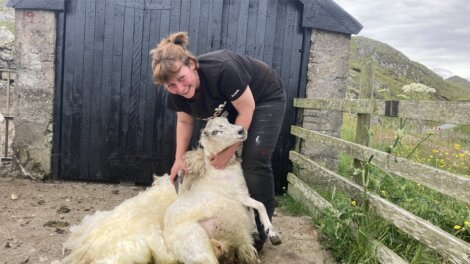Business / Local wool still attracting good prices despite drop on mainland
POOR wool prices on the mainland are not reflected locally, according to the manager of a local broker.
Jamieson and Smith’s Derek Goudie said the renowned Shetland wool is still attracting premium prices.
Shetland is not part of the British Wool Board, which gathers, grades and sells wool on behalf of around 35,000 UK sheep farmers, meaning the isles usually fare differently than the mainland.
Prices on the mainland for Scottish wool are said to have plummeted due to the rise of synthetic fibres and the impact the Covid pandemic has had on the hospitality sector, which often uses wool in carpets.
There were reports of some farmers even burning wool last year as the industry on the mainland stalled due to Covid.
Jamieson and Smith buys, grades and sells Shetland wool from 700-plus local farmers and crofters, giving them a source of income.
They deal with around 250,000 kilograms of wool a year – usually more than 80 per cent of what is clipped in Shetland – before passing it onto its parent company, the Bradford based Curtis Direct, where it then goes all over the world.
The business – which also sells its own yarn and knitwear – is based on Lerwick’s North Road, with its wool store often a hive of activity.
“In a lot of ways we’re pretty lucky that they [Curtis Direct] have such a strong interest and are keen on Shetland wool,” Goudie said.
“Our prices are kind of set with our parent company down in Bradford, but Shetland is a premium and we pay a premium price for a Shetland fleece.
“I think what you’re seeing on the news, it doesn’t really reflect what we’re doing.”
Grade one Shetland wool is up in price this year, and although grade three and four is down slightly, “it’s still a lot more than the mainland price”.
Become a member of Shetland News
“We’re pretty lucky we have two pretty good customers that buys a lot of wool for us, and pays a premium price for it being Shetland, so that helps,” Goudie added.
Those are luxury bed business Vispring, and yarn company West Yorkshire Spinners.
Jamieson and Smith have also seen an increase in demand for wool for knitting and crafts.
“I would say it is probably a bit of an increase with folk sitting at home, there’s a lot of folk taken up crafts again. That’s coming thick and fast,” Goudie said.
He added that wool prices in Shetland are a “lot better” than they were a decade ago.
“I’m been here maybe 15 year, and some of that wool [prices] when I started it was abysmal really – but we’ve put in a lot of effort over the last 10 or more years to promote it and increase sales,” Goudie said.
Out on the Westside Jamieson’s of Shetland in Sandness also takes in some wool from local crofters.
It operates the islands’ only commercial woollen mill, and creates Shetland yarn in five different weights and more than 400 colours, as well as knitwear.
In December the company said its sales of hand knitting yarns had increased steadily before lockdown accelerated demand to the point where its existing machinery struggled to cope.
Thanks to funding from Highlands and Enterprise Jamieson’s announced plans to increase capacity and productivity at the mill.
Become a member of Shetland News
Shetland News is asking its readers to consider paying for membership to get additional perks:
- Removal of third-party ads;
- Bookmark posts to read later;
- Exclusive curated weekly newsletter;
- Hide membership messages;
- Comments open for discussion.
If you appreciate what we do and feel strongly about impartial local journalism, then please become a member of Shetland News by either making a single payment, or setting up a monthly, quarterly or yearly subscription.



























